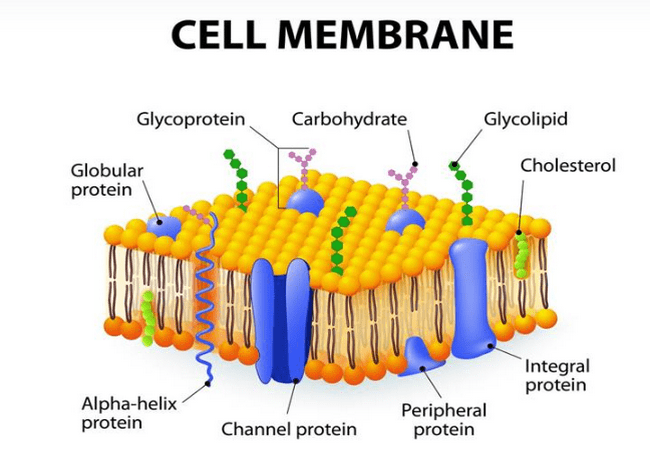What is the Definition of Cell Membrane?

Major Components of the Cell Membrane:
The principal components of the plasma membrane are lipids (phospholipids and cholesterol), proteins (integral protein and peripheral protein), and carbohydrate groups that make a semipermeable barrier surrounding the cell.
- Protein: 55%,
- Lipid: 42%,
- Phospholipid: 25%,
- Cholesterol: 13%,
- Other lipids: 4%,
- Carbohydrates: 3%.
All the above compositions have discussed in the following:
1. Phospholipid:
Phospholipids are mainly built up by the basic structure of a cell membrane. The phospholipids of a cell membrane are organized in a double layer called the lipid bilayer. The lipid bilayer is semi-permeable (controls what gets in and out), allowing only certain ions and organic molecules to diffuse across the membrane. Watery fluids are found both inside a cell (intracellular fluid) and outside a cell (extracellular fluid), cell membrane keeps the balance between those watery fluids. The plasma membranes save the intracellular components from the extracellular environment.
A single phospholipid molecule has two different ends:
- Head ( hydrophilic),
- Tail (hydrophobic).
2. Hydrophilic:
The head end contains a phosphate group and is hydrophilic. The hydrophilic or water-loving areas of these molecules are always contacted with the aqueous fluid both inside and outside the cell. Its head (the phosphate-containing group) has a polar character or negative charge and it tends to form hydrogen bonds with water and other polar molecules on both the exterior and interior of the cell. This means that it likes or is attracted to water molecules.
3. Hydrophobic:
The tail end is made up of two strings of hydrogen and carbon atoms called fatty acid chains. These chains are hydrophobic or do not like to mingle with water molecules. The hydrophobic tail has no charge (non-polar character) and they interact with other non-polar molecules in chemical reactions. The hydrophobic tails of membrane phospholipids are arranged in a manner that keeps them away from water.
4. Proteins:
Proteins are the second key element of plasma membranes. The cell membrane contains two types of associated proteins such as-
Peripheral protein (Peripheral membrane proteins are exterior to and connected to the surfaces of the lipid bilayer).
Integral protein (Integral membrane proteins are inserted into the membrane and most pass through the membrane. Portions of these transmembrane or integral proteins are exposed on both sides of the membrane).
5. Carbohydrates:
Carbohydrates are the third key element of plasma membranes. In general, they are always found on the exterior surface of cells and are bound either to proteins (forming glycoproteins) or to lipids (forming glycolipids). Along with peripheral proteins, carbohydrates make a specialized site on the cell surface that allows cells to recognize each other. This recognition function is very important to cells, that help the immune system to differentiate between body cells (called “self”) and foreign cells or tissues (called “non-self”).

Maria Khatun Mona is a Founder and Editor of Nursing Exercise Blog. She is a Nursing and Midwifery Expert. Currently she is working as a Registered Nurse at Evercare Hospital, Dhaka, Bangladesh. She has great passion in writing different articles on Nursing and Midwifery. Mail her at “maria.mona023@gmail.com”
